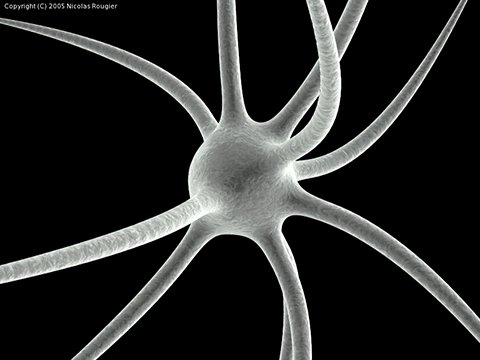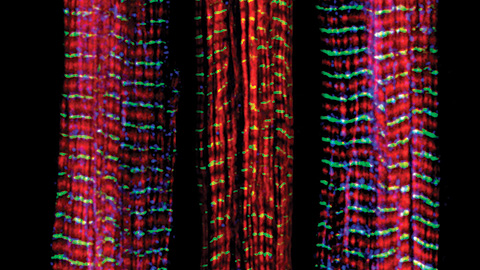From the journals: MCP
Protein analysis of dopaminergic neurons. Predicting immunotherapy responses in lung cancer. ZASP: An efficient proteomics sample prep method. Read about papers on these topics recently published in the journal Molecular & Cellular Proteomics.
Protein analysis of dopaminergic neurons
Dopaminergic neurons regulate fundamental physiological processes such as motivation, reward mechanisms, motor control and mood. They are also the primary cell type affected in Parkinson’s disease, or PD. However, studying dopaminergic neurons can pose challenges due to their heterogeneity and presence in deep brain regions. In addition, most of the protein dynamic studies of dopaminergic neurons have been performed in animal cells, not in cultured human dopaminergic neurons, or hDaNs. Although cellular dynamics of dopaminergic neurons have been analyzed before based on protein turnover in animals, scientists still do not understand these mechanisms in human cells.

In a recent article published in Molecular & Cellular Proteomics, Claudia Cavarischia–Rega, Karan Sharma and a research team at the University of Tübingen, Germany, analyzed protein composition, turnover and the spatial regulation in untreated, healthy human induced pluripotent stem cells, or iPSC, -derived hDaNs. They performed mass spectrometry and a differential dynamic labeling technique, called dynamic stable isotope labeling with amino acids in cell culture, or SILAC, to analyze the human iPSC-derived hDaNs in microfluidic devices.
The authors produced the first protein turnover dataset for iPSC-derived hDaNs and identified novel axonal markers. In addition, they detected translocation of proteins between neuronal structures, the axon and soma, and identified proteins involved in axon guidance, synaptic vesicle trafficking and mitochondrial homeostasis, which promote neuronal health. They also detected a significant over-representation of PD-related proteins.
These findings set a foundation for PD research and other neurodegenerative diseases in exploring the dynamic proteome of dopaminergic neurons. The quantitative proteomics workflow can be integrated for future studies of iPSC–derived human neurons for further research on protein turnover and trafficking in the context of neurodegenerative diseases.
Predicting immunotherapy responses in lung cancer
Scientists have developed immunotherapy as a promising cancer treatment to improve patient survival rates. Programmed death-ligand, or PD-L1, is currently the only biomarker that identifies patients who will likely respond to immunotherapy. Immune checkpoint inhibitors, or ICIs, including the monoclonal antibody drug pembrolizumab, target PD-L1 to stimulate an immune response against cancer cells. Although ICIs are effective in treating patients with non–small cell lung cancer, or NSCLC, physicians cannot accurately predict the efficacy and safety of ICIs in individual patients. Therefore, the identification of novel biomarkers can help select patients who may benefit from immunotherapy.
Patricia Mondelo–Macía of the Universidade de Santiago de Compostela and a team of researchers in Spain published an article in Molecular & Cellular Proteomics in which they analyzed plasma proteins in responder and nonresponder NSCLC patients before and after pembrolizumab therapy. They used a proteomic data analysis tool called sequential window acquisition of all theoretical mass spectra to identify and quantify thousands of proteins. Among these, they identified seven circulating proteins with statistically significant differences, including autophagy-related 9A, or ATG9A, doublecortin domain-containing 2, or DCDC2, Hermansky-Pudlak syndrome 5, or HPS5, filamin A interacting protein 1-like, or FIL1L, and more. These proteins play a role in diverse functions, including cell signaling, cognition and autophagy. Notably, these markers predicted immunotherapy responses better than PD-L1 expression alone in patients with advanced NSCLC. Future investigations will focus more on larger and homogeneous patient cohorts including translating identified circulating proteins into clinical assays.
ZASP: An efficient proteomics sample prep method
Sample preparation plays a crucial role in the proteomics workflow, enabling protein extraction and impurity removal for liquid chromatography–mass spectrometry, or LC–MS, analysis. Traditional preparation methods rely on strong detergents like sodium dodecyl sulfate, or SDS, which interfere with LC–MS and are difficult to remove. Detergent-free methods exist, but they are time-consuming, expensive, labor-intensive and amenable to sample loss. Therefore, scientists need a robust, reproducible and cost-effective universal sample preparation method compatible with LC–MS.
Xianfeng Shao of the Beijing Institute of Lifeomics and a team in China published a study in Molecular & Cellular Proteomics describing an LC–MS preparation method called ZnCl2 precipitation-assisted sample preparation, or ZASP. The method combines zinc chloride, or ZnCl2 and methanol-induced precipitation with an in-solution digestion where proteins are efficiently broken down into peptides in a liquid buffer. ZASP allows researchers to use LC–MS incompatible strong detergents during lysis and increases protein recovery from lysates compared to traditional preparation methods. In addition, ZASP is performed at room temperature, is cost-effective and requires minimal time and equipment. Compared to the common detergent removal methods, ZASP showed higher protein recovery with fewer missed protein cleavages. These results suggest that ZASP could be widely adopted as a universal sample preparation method for proteomics.
Enjoy reading ASBMB Today?
Become a member to receive the print edition four times a year and the digital edition monthly.
Learn moreGet the latest from ASBMB Today
Enter your email address, and we’ll send you a weekly email with recent articles, interviews and more.
Latest in Science
Science highlights or most popular articles

The science of staying strong
Muscles power every movement, but they also tell the story of aging itself. Scientists are uncovering how strength fades, why some species resist it and what lifestyle and molecular clues could help preserve muscle health for life.

Bacteriophage protein could make queso fresco safer
Researchers characterized the structure and function of PlyP100, a bacteriophage protein that shows promise as a food-safe antimicrobial for preventing Listeria monocytogenes growth in fresh cheeses.

Building the blueprint to block HIV
Wesley Sundquist will present his work on the HIV capsid and revolutionary drug, Lenacapavir, at the ASBMB Annual Meeting, March 7–10, in Maryland.

Gut microbes hijack cancer pathway in high-fat diets
Researchers at the Feinstein Institutes for Medical Research found that a high-fat diet increases ammonia-producing bacteria in the gut microbiome of mice, which in turn disrupts TGF-β signaling and promotes colorectal cancer.

Mapping fentanyl’s cellular footprint
Using a new imaging method, researchers at State University of New York at Buffalo traced fentanyl’s effects inside brain immune cells, revealing how the drug alters lipid droplets, pointing to new paths for addiction diagnostics.

Designing life’s building blocks with AI
Tanja Kortemme, a professor at the University of California, San Francisco, will discuss her research using computational biology to engineer proteins at the 2026 ASBMB Annual Meeting.

